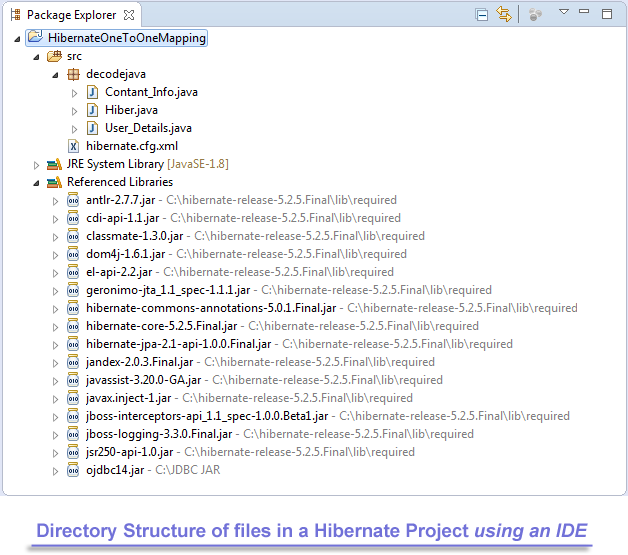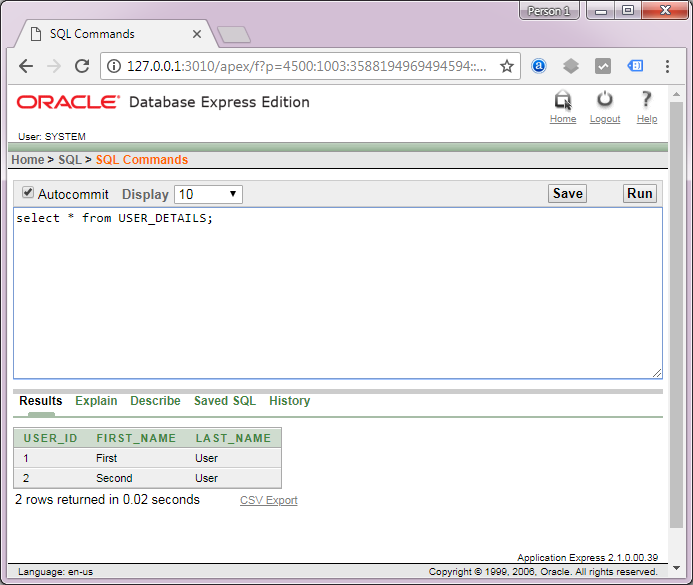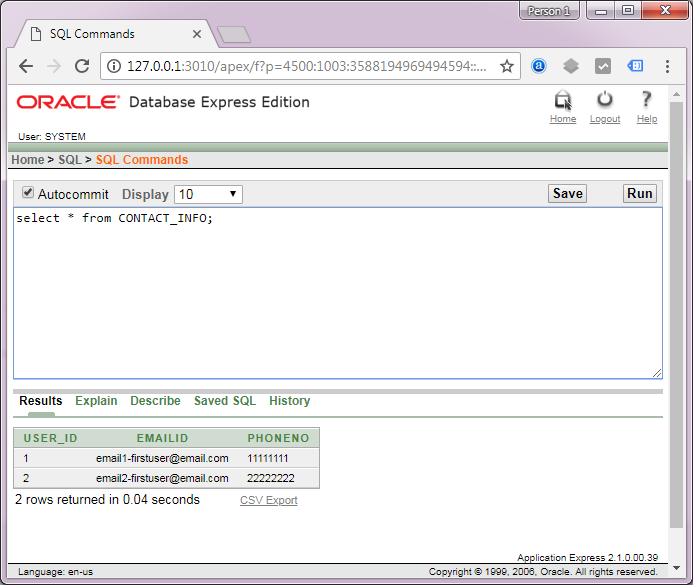Advertisement
cascade = {CascadeType.ALL}package decodejava;
import javax.persistence.CascadeType;
import javax.persistence.Column;
import javax.persistence.Entity;
import javax.persistence.GeneratedValue;
import javax.persistence.Id;
import javax.persistence.OneToOne;
import javax.persistence.Table;
@Entity
@Table (name ="USER_DETAILS")
public class User_Details {
@Id
@GeneratedValue
@Column (name = "USER_ID")
private int id;
@Column (name = "First_Name")
private String firstName;
@Column (name = "Last_Name")
private String lastName;
@OneToOne(cascade = {CascadeType.ALL}, mappedBy = "user")
private Contact_Info contact;
public Contact_Info getContact()
{
return contact;
}
public void setContact(Contact_Info contact)
{
this.contact = contact;
}
public int getId()
{
return id;
}
public void setId(int id)
{
this.id = id;
}
public String getFirstName()
{
return firstName;
}
public void setFirstName(String firstName)
{
this.firstName = firstName;
}
public String getLastName()
{
return lastName;
}
public void setLastName(String lastName)
{
this.lastName = lastName;
}
}Advertisement
package decodejava;
import javax.persistence.CascadeType;
import javax.persistence.Column;
import javax.persistence.Embeddable;
import javax.persistence.Entity;
import javax.persistence.GeneratedValue;
import javax.persistence.GenerationType;
import javax.persistence.Id;
import javax.persistence.OneToOne;
import javax.persistence.PrimaryKeyJoinColumn;
import javax.persistence.SequenceGenerator;
import javax.persistence.Table;
@Entity
@Table (name ="CONTACT_INFO")
public class Contact_Info
{
@Id
@Column(name="USER_ID")
@SequenceGenerator(name = "id_generator", sequenceName = "id_seq")
@GeneratedValue(strategy = GenerationType.SEQUENCE, generator = "id_generator")
private int id;
private String emailId;
private String phoneNo;
@OneToOne(cascade=CascadeType.ALL)
@PrimaryKeyJoinColumn
private User_Details user;
public int getId()
{
return id;
}
public void setId(int id)
{
this.id = id;
}
public User_Details getUser()
{
return user;
}
public void setUser(User_Details user)
{
this.user = user;
}
public String getEmailId()
{
return emailId;
}
public void setEmailId(String emailId)
{
this.emailId = emailId;
}
public String getPhoneNo()
{
return phoneNo;
}
public void setPhoneNo(String phoneNo)
{
this.phoneNo = phoneNo;
}
}package decodejava;
import java.util.HashSet;
import org.hibernate.Session;
import org.hibernate.SessionFactory;
import org.hibernate.cfg.Configuration;
public class Hiber
{
public static void main(String... ar)
{
Configuration config = new Configuration();
SessionFactory sf = config.configure().buildSessionFactory();
Session session = sf.openSession();
//Creating the first User details
User_Details user1 = new User_Details();
user1.setFirstName("First");
user1.setLastName("User");
//Creating the contact info for the user
Contact_Info contact1 = new Contact_Info();
contact1.setEmailId("email1-firstuser@email.com");
contact1.setPhoneNo("11111111");
//Setting the contact info of the first user
user1.setContact(contact1);
//Setting the first Contact_Info object to its correspoding user to create a one-to-one bidirectional relationship
contact1.setUser(user1);
//Creating the second User details
User_Details user2 = new User_Details();
user2.setFirstName("Second");
user2.setLastName("User");
//Creating another contact info for the same user
Contact_Info contact2 = new Contact_Info();
contact2.setEmailId("email2-firstuser@email.com");
contact2.setPhoneNo("22222222");
//Setting the contact info of the second user
user2.setContact(contact2);
//Setting the second Contact_Info object to its correspoding user to create a one-to-one bidirectional relationship
contact2.setUser(user2);
session.beginTransaction();
session.save(user1); //Saving the first User_Details object
session.save(user2); //Saving the Second User_Details object
session.getTransaction().commit();
session.close();
//Retrieve and displaying the user details.
session = sf.openSession();
session.beginTransaction();
user1 = (User_Details)session.get(User_Details.class,1);
user2 = (User_Details)session.get(User_Details.class,2);
System.out.println("Retrieving the saved objects");
//Retrieving details of the first user.
System.out.println("First User");
System.out.println("Id : " + user1.getId());
System.out.println("First Name : " + user1.getFirstName());
System.out.println("Last Name : " +user1.getLastName());
contact1 = user1.getContact();
System.out.println("Email id : " + contact1.getEmailId());
System.out.println("Phone number : " + contact1.getPhoneNo());
//Retrieving details of the seco d user.
System.out.println("Second User");
System.out.println("Id : " + user2.getId());
System.out.println("First Name : " + user2.getFirstName());
System.out.println("Last Name : " +user2.getLastName());
contact2 = user2.getContact();
System.out.println("Email id : " + contact1.getEmailId());
System.out.println("Phone number : " + contact1.getPhoneNo());
session.getTransaction().commit();
session.close();
}
}<?xml version="1.0" encoding="utf-8"?>
<!DOCTYPE hibernate-configuration PUBLIC
"-//Hibernate/Hibernate Configuration DTD 3.0//EN"
"http://www.hibernate.org/dtd/hibernate-configuration-3.0.dtd">
<hibernate-configuration>
<session-factory>
<!-- Database connection settings -->
<property name="connection.driver_class">oracle.jdbc.driver.OracleDriver</property>
<property name="connection.url">jdbc:oracle:thin:@localhost:1521:XE</property>
<property name="connection.username">scott</property>
<property name="connection.password">tiger</property>
<!-- JDBC connection pool (use the built-in) -->
<property name="connection.pool_size">1</property>
<!-- SQL dialect -->
<property name="dialect">org.hibernate.dialect.Oracle10gDialect</property>
<!-- Disable the second-level cache -->
<property name="cache.provider_class">org.hibernate.cache.internal.NoCacheProvider</property>
<!-- Echo all executed SQL to stdout -->
<property name="show_sql">true</property>
<!-- Drop and re-create the database schema on startup -->
<property name="hbm2ddl.auto">create</property>
<!-- Names the mapping entity class -->
<mapping class ="decodejava.User_Details"/>
<mapping class ="decodejava.Contact_Info"/>
</session-factory>
</hibernate-configuration>
Hibernate: create sequence hibernate_sequence start with 1 increment by 1
Hibernate: create sequence id_seq start with 1 increment by 1
Hibernate: create table CONTACT_INFO (USER_ID number(10,0) not null, emailId varchar2(255 char), phoneNo varchar2(255 char), primary key (USER_ID))
Hibernate: create table USER_DETAILS (USER_ID number(10,0) not null, First_Name varchar2(255 char), Last_Name varchar2(255 char), primary key (USER_ID))
Hibernate: select hibernate_sequence.nextval from dual
Hibernate: select id_seq.nextval from dual
Hibernate: select id_seq.nextval from dual
Hibernate: select hibernate_sequence.nextval from dual
Hibernate: insert into USER_DETAILS (First_Name, Last_Name, USER_ID) values (?, ?, ?)
Hibernate: insert into CONTACT_INFO (emailId, phoneNo, USER_ID) values (?, ?, ?)
Hibernate: insert into USER_DETAILS (First_Name, Last_Name, USER_ID) values (?, ?, ?)
Hibernate: insert into CONTACT_INFO (emailId, phoneNo, USER_ID) values (?, ?, ?)
Hibernate: select user_detai0_.USER_ID as USER_ID1_1_0_, user_detai0_.First_Name as First_Name2_1_0_, user_detai0_.Last_Name as Last_Name3_1_0_, contact_in1_.USER_ID as USER_ID1_0_1_, contact_in1_.emailId as emailId2_0_1_, contact_in1_.phoneNo as phoneNo3_0_1_ from USER_DETAILS user_detai0_ left outer join CONTACT_INFO contact_in1_ on user_detai0_.USER_ID=contact_in1_.USER_ID where user_detai0_.USER_ID=?
Hibernate: select user_detai0_.USER_ID as USER_ID1_1_0_, user_detai0_.First_Name as First_Name2_1_0_, user_detai0_.Last_Name as Last_Name3_1_0_, contact_in1_.USER_ID as USER_ID1_0_1_, contact_in1_.emailId as emailId2_0_1_, contact_in1_.phoneNo as phoneNo3_0_1_ from USER_DETAILS user_detai0_ left outer join CONTACT_INFO contact_in1_ on user_detai0_.USER_ID=contact_in1_.USER_ID where user_detai0_.USER_ID=?
Retrieving the saved objects
First User
Id : 1
First Name : First
Last Name : User
Email id : email1-firstuser@email.com
Phone number : 11111111
Second User
Id : 2
First Name : Second
Last Name : User
Email id : email1-firstuser@email.com
Phone number : 11111111 select * from USER_DETAILS; 
select * from CONTACT_INFO; 
Advertisement
Advertisement
Please check our latest addition
C#, PYTHON and DJANGO
Advertisement